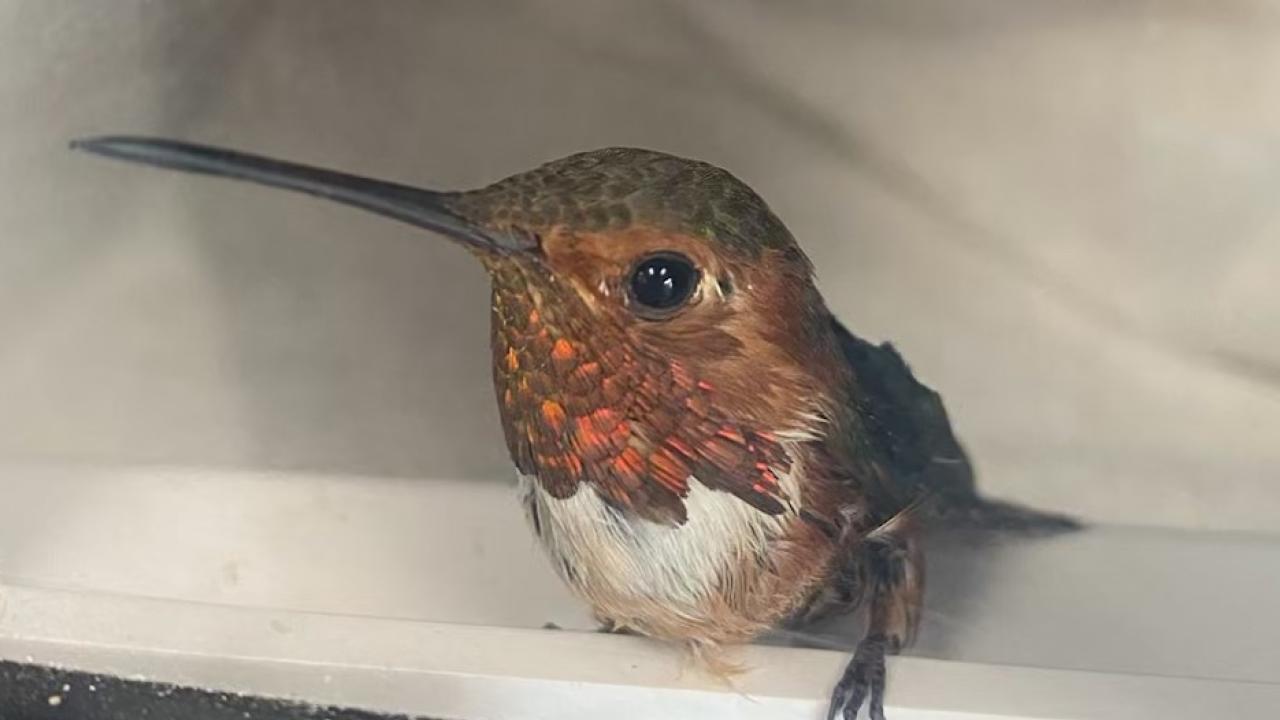
Tiny But Mighty: The Remarkable Rescue of an Oiled Hummingbird in Marina del Rey
The Yacht Fire and Oil Spill
On September 18, 2024, a luxury yacht docked in Marina del Rey caught fire. Two people were on board, but managed to evacuate without injuries. In addition to 4,000 gallons of red-dye diesel, the 100-foot yacht was carrying ammunition and fireworks. The resulting explosions created a dramatic spectacle. Although these pyrotechnics weren’t intended to haze wildlife, they likely had an incidental deterrent effect, keeping nearby wildlife away from the area. It's not every day that an oil spill comes with its own wildlife hazing! Despite efforts by firefighters to extinguish the blaze, the yacht began to list and ultimately sank. The Coast Guard and the California Department of Fish and Wildlife – Office of Spill Prevention and Response (CDFW-OSPR) monitored the subsequent oil spill response and the yacht’s recovery. CDFW-OSPR quickly notified the Oiled Wildlife Care Network (OWCN), and we were on standby to address any reports of impacted wildlife.
During a marine oil spill like this one, the OWCN anticipates potential impacts to species that spend at least part of their lives in the sea. Wildlife such as California sea lions and seabirds are usually at the top of the list in Marina del Rey. However, as often happens during oil spills, there were some unexpected surprises!

The Oiled Hummingbird Rescue
On September 20th, CDFW-OSPR called the OWCN Hotline to report an oiled hummingbird (!) found struggling in the oil sheen at the marina. CDFW-OSPR staff safely recovered the tiny bird from the water and, following OWCN’s guidance, transported it to the Los Angeles Oiled Bird Care and Education Center (LAOBCEC) in San Pedro. International Bird Rescue staff were standing by to receive the oil-soaked hummingbird and begin the delicate process of stabilizing him.

The Rehabilitation Process
The bird, a male Allen’s Hummingbird weighing just three grams, is believed to be the smallest avian patient in OWCN history! The response team was cautious about his prognosis. Hummingbirds require specialized care, and diesel contamination can cause skin burns. Though the bird was in good body condition, his uncoordinated movements suggested exhaustion and missed meals. Hummingbirds have one of the highest metabolic rates on Earth, which makes them especially vulnerable in situations like this.
With all of this in mind, the response team formed a plan to provide nutrition and heat support, then proceeded with a quick wash to remove most of the diesel in order to mitigate the effects of the contaminant on the bird’s skin. The initial stabilization of this tiny hummingbird was a delicate process. Due to his small size, rapid metabolism, and the toxicity of the diesel, the response team had to take special care with each step.
Their meticulous work paid off! The Allen’s hummingbird survived the quick wash, and his strength began to return after a full day of careful feeding. The following morning, he was transferred to Wetlands and Wildlife Care Center (WWCC) for further treatment. Once at WWCC, response staff assessed the hummingbird’s waterproofing by misting him with a spray bottle and providing a bathing dish. When staff determined that the bird’s feathers were not becoming more waterproofed through his own bathing and preening attempts, a second and final wash was performed to fully remove any lingering contaminant.
While in care, the hummingbird ate a specialized diet of nectar formula and fruit flies. Over the following days, the hummingbird’s weight, attitude, behavior, and waterproofing were carefully monitored. Response staff knew that the bird’s waterproofing had been restored when bathing and misting no longer resulted in his feathers holding water.

A Successful Release
After ten days of specialized care and monitoring, the Allen’s Hummingbird was finally ready to return to the wild. Following a final health assessment, CDFW-OSPR staff transported this tiny VIP (very important patient) back to Marina del Rey for release. The hummingbird was eager to exit his transport carrier and quickly flew off to get reacquainted with his home territory. This success story serves as a powerful reminder of the resilience of wildlife and the extraordinary skill of OWCN’s dedicated responders, whose collaboration makes these life-saving rescues possible.

